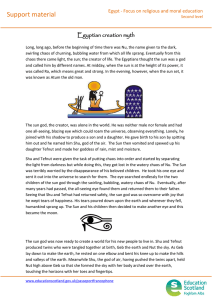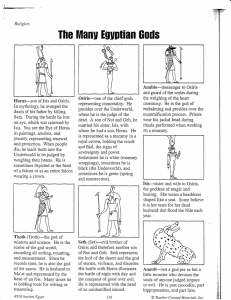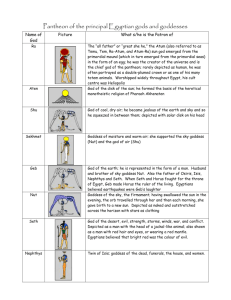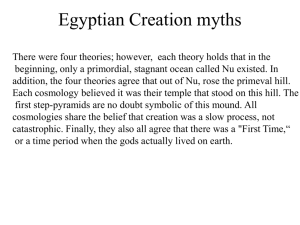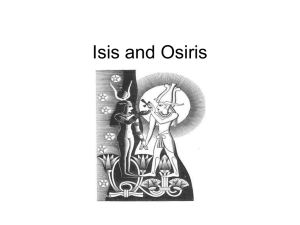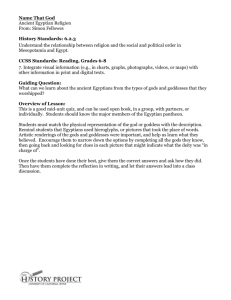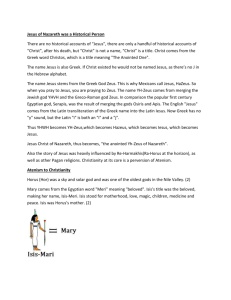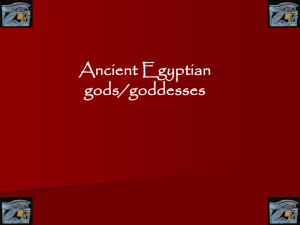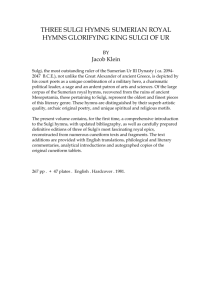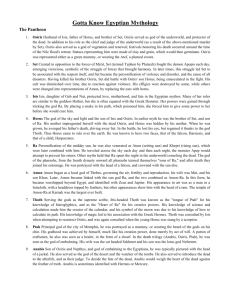egypt 2010 - Valdosta State University
advertisement
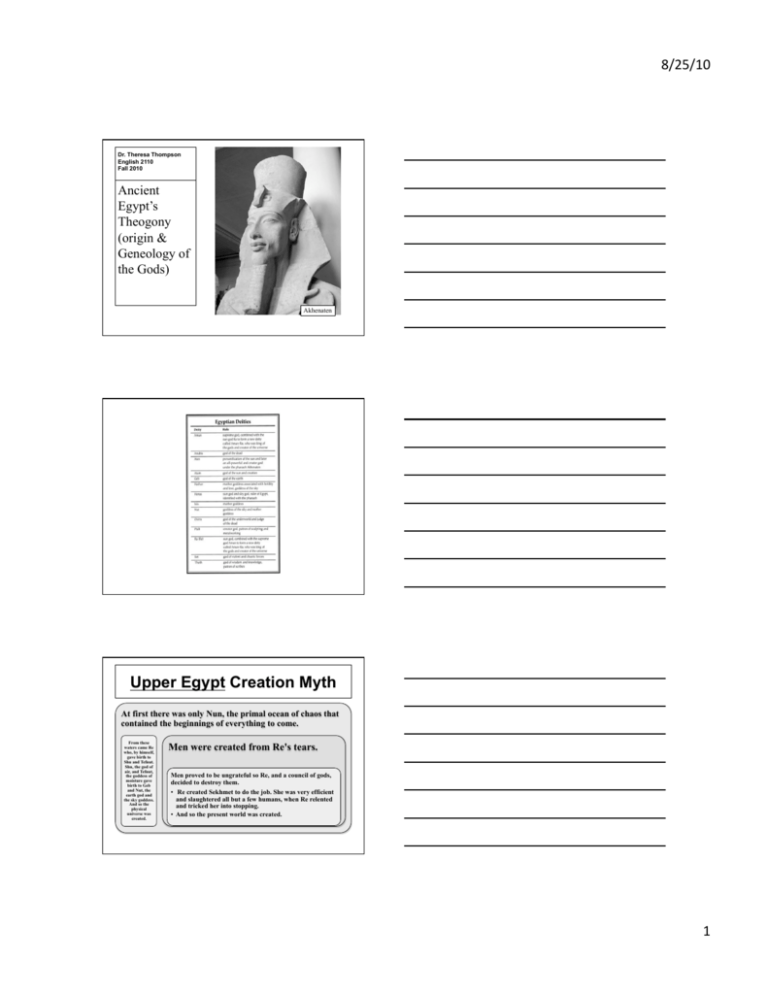
8/25/10 Dr. Theresa Thompson English 2110 Fall 2010 Ancient Egypt’s Theogony (origin & Geneology of the Gods) Akhenaten Upper Egypt Creation Myth At first there was only Nun, the primal ocean of chaos that contained the beginnings of everything to come. From these waters came Re who, by himself, gave birth to Shu and Tefnut. Shu, the god of air, and Tefnut, the goddess of moisture gave birth to Geb and Nut, the earth god and the sky goddess. And so the physical universe was created. Men were created from Re's tears. Men proved to be ungrateful so Re, and a council of gods, decided to destroy them. • Re created Sekhmet to do the job. She was very efficient and slaughtered all but a few humans, when Re relented and tricked her into stopping. • And so the present world was created. 1 8/25/10 Against Re's orders, Geb and Nut married. Re was angry and ordered Shu to separate them, which he did. Thoth, the god of learning, decided to help Nut and gambled with the moon for extra daylight. He won five extra days, which he added to the 360-day calendar. Nut was already pregnant, but unable to give birth because Re had decreed she could not give birth in any month of any year. During those five days, Nut gave birth to five children: Osiris, Horus the Elder, Set, Isis, and Nephthys. Osiris became the symbol of good and Set became the symbol of evil. These two poles of morality became fixed in Egyptian theology. Lower Egypt Creation Myth Only the ocean existed at first. Then Re (the sun) came out of an egg that appeared on the surface of the water. Re brought forth four children, the gods Shu and Geb and the goddesses Tefnut and Nut. Shu and Tefnut became the atmosphere. They stood on Geb, who became the earth, and raised up Nut, who became the sky. Re ruled over all. Geb and Nut later had two sons, Set and Osiris, and two daughters, Isis and Nephthys. Osiris succeeded Re as king of the earth, helped by Isis, his sister-wife. Set hated his brother and killed him. Isis embalmed her husband Osiris's body with the help of the god Anubis, who thus became the god of embalming. The powerful charms of Isis resurrected Osiris. Osiris has many different titles: god of fertility, king of the dead, god of agriculture, and god of the underworld, controller of the Nile floods, and the rising and setting of the sun. All of these titles have one thing in common: life, death, and rebirth. Horus, son of Osiris and Isis, defeated Set in a great battle and became king of the earth. (Leiden Hymns, lines 1-8, pp. 46-47) 2 8/25/10 Theology: rational inquiry into religious questions. Ancient Egyptians recognized a difference between natural forces and cultural (human) behavior, but believed superhuman powers ruled both. The annual flooding of the Nile and the daily cycle of the sun’s appearance influenced their view of the supernatural. (Leiden Hymns, “Perfect Knowing,” lines 5-27, p. 48) Egyptian devotional literature consisted of hymns, prayers, and induction rituals. Hymns exclusively praised one god or one goddess, as does Adoration of Re in the Egyptian Book of the Dead. Some hymns beseech a deity for intercession, favors or blessings. Hymns represent “the ancient Egyptian equivalent of the philosophical writings of the Greeks and the theological treatises of medieval scholars” (Allen 242). Most hymns provide vehicle for theologians to eternalize and transmit their thoughts about divinity. Akhenaten’s “Hymn to the Sun” ; (~1378-1358 b.c.e.) Focus on Aten the Sun God. Rewrites creation mythologies and geneology of Egyptian gods. Akhenaten’s “Hymn” elevates Aten to the position of a single, unparented creator deity (V, VII, XI). Aten orders and organizes the world according to his heart’s desires: status, food rations, skin color (VIII) Aten is known fully only by Akhenaten (XII) The Leiden Hymns (~1238 b.c.e.) • Re-Harakhti (Horus of the Twin Horizons) is union of Re and Horus at midday. – Self-insemination (p. 47, lines 9-16) • Amun spoke himself into being. (48) – “I am!” – All other gods came after! Goddess Hathor and Re-Harakhti (Horus of the Twin Horizons) • Re-Harakhti has “perfect knowing” (48) 3 8/25/10 Works Consulted • Allen, J.P. : Middle Egyptian Cambridge: Cambridge UP, 2000. • Frankfort, H. Kingship and the Gods. Chicago: U of Chicago P, 1979. 4

